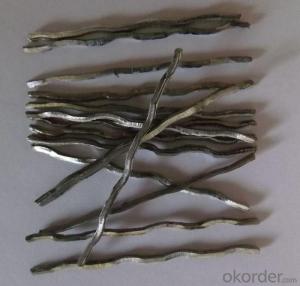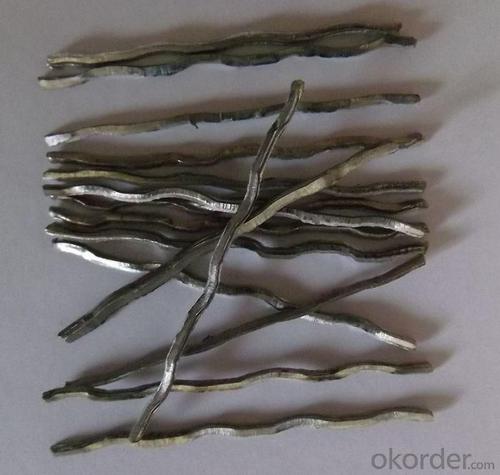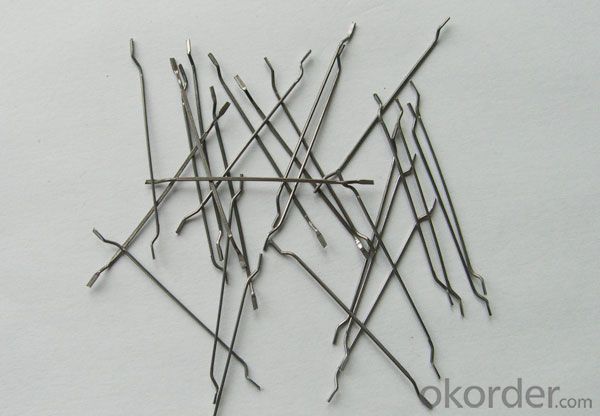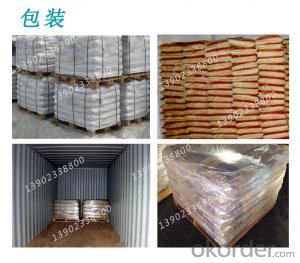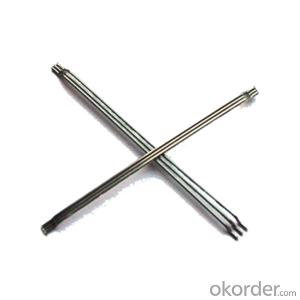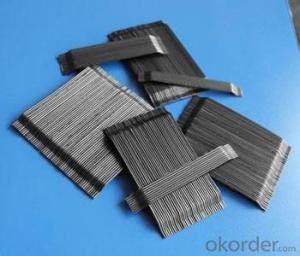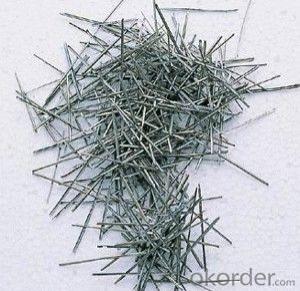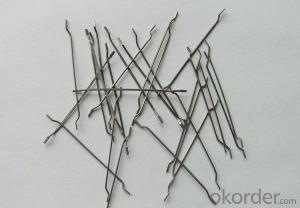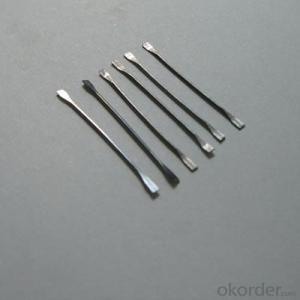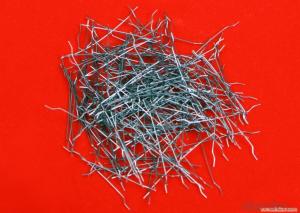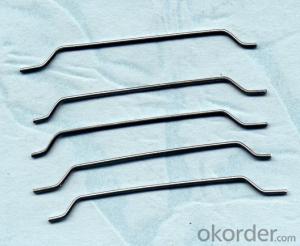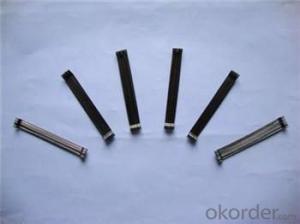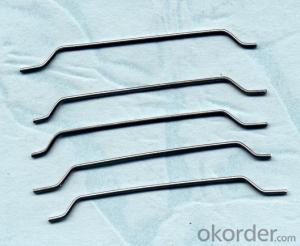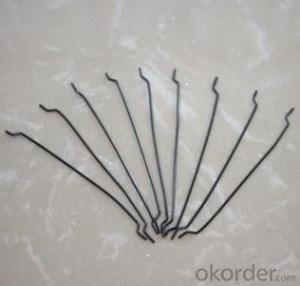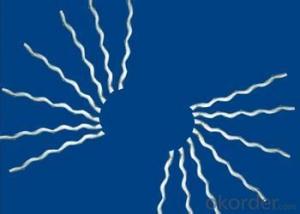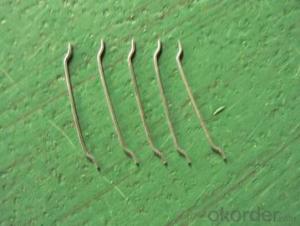Melt Extract Stainless Steel Fiber for Steel Fiber Dedicated Copper Military Engineering
- Loading Port:
- Tianjin
- Payment Terms:
- TT OR LC
- Min Order Qty:
- 1000 kg
- Supply Capability:
- 250000 kg/month
OKorder Service Pledge
OKorder Financial Service
You Might Also Like
Quick Details
Place of Origin: Shandong, China (Mainland)
Model Number: steel fiber
material: steel wire
application: concrete reinocement
type: end hook steel fiber
Product features
with excellent tensile ,hightenacity ,against cracking and fatigue ,they`re widely usd in the structures made of concrete
1.Material:high-quality steel wire
2.Diameter:0.18mm-0.3mm
3.Length:6mm-20mm
4.Tensile strength is >2850MPa
5.ISO9001:2000
Material:high quality low carbon steel wire,copper coated
Diameter:0.18mm --0.3mm
Length: 6mm-20mm
Tensile strength:>2850Mpa
Feature:Excellent tensile, bending and shearing strength, resistance
against cracking, impact and fatigue.
Use:It is widely used for buildings, road surface, bridges, tunnels,
airport road surface, water conservancy projects, military
engineering, and all kinds of building products.
Specifications
1.hooked steel fiber
2.CE and ISO9001:2008
3.diameter from 0.5mm to 1.2mm
4.competitive price,high quality and service
Hooked Steel Fiber:
1.Diameter:0.5mm-1.0mm
2.Length: 25mm-60mm
3.Material: low carbon steel wire
4.Feature: excellent tensile,high tenacity,against cracking,impact and fatigue
5.Uses: high way,tunnel,building,airport road serface and so on .
Picture
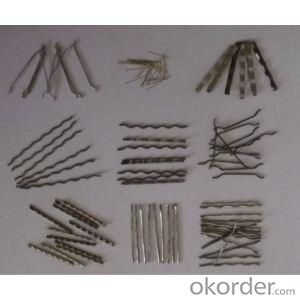
steel fiber concrete reinforced
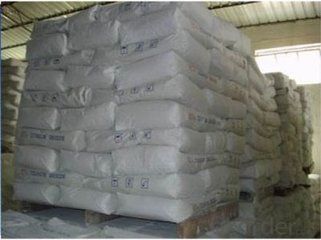
any type steel fiber
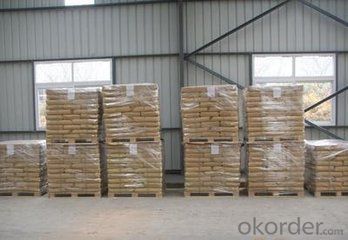
FAQ
we can produce any type steel fiber and of course we can make production according to your requirement
we have specilize in this field for almost 10 years ,with good quality and competitive price
with excellent tensile ,hightenacity ,against cracking and fatigue ,they`re widely usd in the structures made of concrete
- Q: How does melt extract stainless steel fiber improve the toughness of fiber-reinforced shotcrete?
- The toughness of fiber-reinforced shotcrete can be greatly improved by the addition of melt extract stainless steel fiber, thanks to its unique properties and characteristics. By adding these stainless steel fibers to shotcrete, the overall performance and durability of the concrete are enhanced, resulting in increased tensile and flexural strength. The primary reason why melt extract stainless steel fiber improves the toughness of fiber-reinforced shotcrete is its ability to resist cracking and control crack propagation. Shotcrete is susceptible to cracking under various stress conditions, such as shrinkage, thermal changes, or external forces. These cracks can weaken the structure and compromise its integrity. However, incorporating stainless steel fibers acts as reinforcement, creating a three-dimensional network within the shotcrete matrix. The steel fibers act as micro-reinforcement, helping to distribute the stress load more evenly throughout the concrete. This redistribution of stress effectively minimizes the formation and propagation of cracks. The fibers also act as bridging elements, preventing cracks from widening and spreading further. This improved crack control significantly enhances the toughness of the shotcrete, making it more resilient to external forces and reducing the risk of failure. Moreover, melt extract stainless steel fibers possess excellent corrosion resistance properties, which is crucial for shotcrete applications in aggressive environments or structures exposed to moisture and chemicals. Unlike other types of fibers, such as carbon or polypropylene, stainless steel fibers do not degrade over time due to corrosion. This ensures the long-term durability and performance of the fiber-reinforced shotcrete, even in challenging conditions. Furthermore, the high aspect ratio and small diameter of melt extract stainless steel fibers result in a high surface area, enabling better bonding with the shotcrete matrix. This improved bond strength between the fibers and the concrete further enhances the toughness and overall mechanical properties of the shotcrete. In conclusion, melt extract stainless steel fiber enhances the toughness of fiber-reinforced shotcrete by controlling crack formation and propagation, improving bond strength, and providing excellent corrosion resistance. These properties make it an ideal choice for reinforcing shotcrete in various construction applications, including tunnels, bridges, slope stabilization, and structural repairs.
- Q: Can melt extract stainless steel fiber be used in retaining wall construction?
- Yes, melt extract stainless steel fiber can be used in retaining wall construction. It provides added strength, durability, and resistance to cracking, making it a suitable material for reinforcing concrete in retaining walls.
- Q: Can melt extract stainless steel fiber be used in fiber-reinforced cementitious composites (FRCCs)?
- Certainly, melt extract stainless steel fiber is a viable option for reinforcing fiber-reinforced cementitious composites (FRCCs). Melt extract stainless steel fibers are frequently preferred due to their exceptional tensile strength, resistance to corrosion, and long-lasting nature. Incorporating these fibers into cementitious materials can significantly enhance the composite's flexural strength, toughness, and ability to withstand cracks. Moreover, they have the potential to enhance the overall durability and lifespan of FRCCs in a wide range of applications, including structural elements, pavements, and precast products. By utilizing melt extract stainless steel fiber in FRCCs, one can achieve heightened structural integrity, reduced maintenance needs, and enhanced resistance against environmental factors. Therefore, it is a highly suitable choice for reinforcing cementitious composites.
- Q: Does melt extract stainless steel fiber improve the resistance to chloride penetration in concrete?
- Adding melt extract stainless steel fiber to concrete can enhance its resistance to chloride penetration. The corrosion resistance of stainless steel fibers is well-known, making them highly effective in protecting concrete structures from chloride attacks. The penetration of chloride ions into concrete can cause corrosion in the reinforcement and lead to structural deterioration. However, the addition of stainless steel fibers to the concrete mix creates a network that improves overall durability and resistance to chloride penetration. These fibers act as a barrier, impeding the movement of chloride ions and reducing their ability to reach the reinforcement. As a result, the concrete exhibits improved resistance to chloride-induced corrosion, leading to an extended service life for the structure.
- Q: Can melt extract stainless steel fiber be used in tunnel construction?
- Melt extract stainless steel fiber is indeed applicable to tunnel construction. Renowned for their exceptional tensile strength, resistance to corrosion, and long-lasting nature, stainless steel fibers are perfectly suited for endeavors that demand structural integrity, like tunnel construction. These fibers have the ability to enhance the mechanical attributes of concrete, thereby bolstering its ability to withstand cracking, thermal expansion, and shrinkage. Moreover, they can serve as reinforcement within tunnel linings, thereby reducing the necessity for conventional reinforcement techniques like rebar. This leads to considerable cost savings and quicker completion times. All in all, melt extract stainless steel fiber is a trustworthy and efficient option when it comes to tunnel construction projects.
- Q: Can melt extract stainless steel fiber be used in foundation slabs?
- Yes, melt extract stainless steel fiber can be used in foundation slabs. These fibers provide reinforcement and improve the overall strength and durability of the concrete. They are commonly used in industrial and commercial applications where heavy loads and high traffic are expected. The stainless steel fibers are resistant to corrosion and can withstand harsh environmental conditions. They also help to control cracking and improve the overall performance of the foundation slab.
- Q: How does the aspect ratio of melt extract stainless steel fiber affect its performance?
- The aspect ratio of melt extract stainless steel fiber refers to the ratio of its length to diameter. A higher aspect ratio generally leads to improved performance of the fiber. This is because a higher aspect ratio allows for a greater surface area and better interlocking within the matrix material, resulting in enhanced mechanical properties such as increased tensile strength, improved crack resistance, and better overall reinforcement. Additionally, a higher aspect ratio can enhance the fiber's ability to distribute stress evenly, leading to improved durability and longevity.
- Q: What is the effect of melt extract stainless steel fiber on the carbonation resistance of concrete?
- The carbonation resistance of concrete is positively affected by the utilization of melt extract stainless steel fiber. Stainless steel fibers, renowned for their high corrosion resistance, play a crucial role in safeguarding the concrete against carbonation. Carbonation occurs when carbon dioxide from the atmosphere reacts with the calcium hydroxide present in the concrete, resulting in the formation of calcium carbonate. This chemical reaction can lower the pH level within the concrete, rendering it more susceptible to corrosion of the reinforcing steel. By incorporating melt extract stainless steel fibers into the concrete mixture, the risk of carbonation is significantly mitigated. These fibers act as a physical barrier, effectively preventing carbon dioxide from permeating the concrete. This, in turn, helps maintain a higher pH level within the material, thereby safeguarding the reinforcing steel and enhancing the overall durability of the concrete structure. Moreover, the utilization of stainless steel fibers enhances the mechanical properties of the concrete, including its tensile strength and flexural strength. This further fortifies the material's resistance to carbonation and other environmental factors. To summarize, the addition of melt extract stainless steel fibers profoundly enhances the carbonation resistance of concrete. As a result, concrete structures benefit from increased durability, reduced maintenance requirements, and an extended service life.
- Q: Can melt extract stainless steel fiber be used in lightweight concrete applications?
- Yes, melt extract stainless steel fiber can be used in lightweight concrete applications. The addition of stainless steel fibers enhances the strength and durability of lightweight concrete, making it suitable for a wide range of construction applications.
- Q: How does melt extract stainless steel fiber enhance the crack resistance of concrete?
- Melt extract stainless steel fiber enhances the crack resistance of concrete by improving its tensile strength and ductility. These fibers act as reinforcement within the concrete matrix, effectively bridging micro-cracks and preventing their propagation. Additionally, the high aspect ratio of these fibers enhances the bonding between the fiber and the surrounding concrete, further enhancing its resistance to cracking.
Send your message to us
Melt Extract Stainless Steel Fiber for Steel Fiber Dedicated Copper Military Engineering
- Loading Port:
- Tianjin
- Payment Terms:
- TT OR LC
- Min Order Qty:
- 1000 kg
- Supply Capability:
- 250000 kg/month
OKorder Service Pledge
OKorder Financial Service
Similar products
Hot products
Hot Searches
Related keywords
